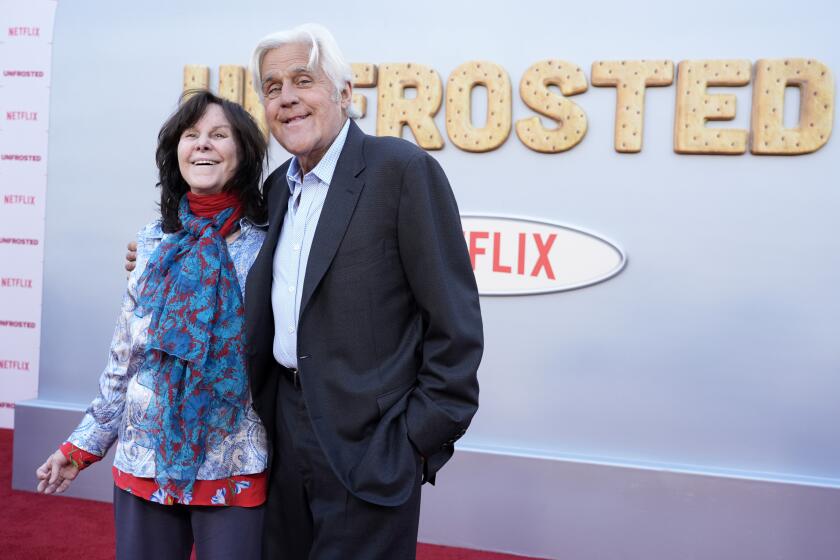Knocking Crown Off ‘Queen Tina’ Brown
- Share via
Magazines reflect and inform the culture like no other medium, and Vanity Fair has influenced magazines like no other publication of late. So Tina Brown, the editor-in-chief who made Vanity Fair what it is, is a natural profile subject.
“Queen Tina,” in the May issue of Spy, is different from most recent portraits of Brown, though--more like the profiles writers did before Vanity Fair’s pull-those-punches approach became pervasive.
Few would dispute that Vanity Fair is the magazine success story of the ‘80s. But, writes Geoffrey Stokes, it is an ‘80s-style success story.
Brown schmoozed her way to the top, he says, working the party scene for all it was worth, shamelessly kissing up to the powerful in her magazine’s pages and publishing eyebrow-raising puffery on such advertisers as Calvin Klein.
When necessary to maintain the right connections, Brown’s Vanity gushes over the offspring of the rich and famous--and her own two children have nearly a dozen influential godparents between them, Stokes writes, with a journalistic smirk.
Now, like so many ‘80s successes, “Vanity Fair is overburdened with the weight of its own corruption,” Stokes argues. Brown, he says, has become like Lucy in the Peanuts comic strip, holding the football of wit and satire for her hapless Charlie Brown readers.
“With the same sort of trust he brings to kicking a football, they rip off the shrink wrap, tear into the promised bonbons but find that the most salaciously promising stories are glossy love pats, sly only around the edges that don’t really matter.”
Stokes criticizes what he sees as Brown’s fixation with personality; she thinks readers find ideas boring, so her editors routinely cut stories down to strings of interesting anecdotes that lead nowhere.
But Stokes, too, fails to push his profile to its broader conclusions. He writes that Brown is aware of the most difficult problem facing Vanity: “That a magazine celebrating rich people no longer makes sense.”
Yet he never fully explores Brown’s seemingly insatiable need for acceptance or why superficial profiles of the rich and famous resonate so deeply with so many readers.
REQUIRED READING
* Big as a barn door and louder than a wounded wild boar, talk-show host Rush Limbaugh is an easy target for media liberals.
But in the May issue of Vanity Fair, Peter Boyer avoids the standard hatchet job on the man “with talent on loan from God.” Boyer gives Limbaugh his best shot, even transcribing the conservative gadfly’s ebullient sound effects. As a result, Limbaugh comes across as outrageous but funny, while those who would stifle him--Gloria Allred, for one--seem frighteningly humorless.
* With the Los Angeles Times watching every other medium, it’s only fair that someone keeps an eye on The Times. Local television does a pretty poor job of it, so it’s really up to magazines.
Los Angeles magazine does take gossipy shots at The Times on occasion. But with the May/June issue, Buzz magazine becomes the only venue for a full-time, professional Times-basher.
There are a few small mistakes in the pseudonymous Margo Magee’s first “Our Times” column. Also, Magee gets so worked up about what she sees as The Times’ infatuation with the homeless issue that she sounds herself a bit like Rush Limbaugh. But then, on the very next page, Buzz turns itself over to columnist Holly Palance, who goes on at some length about the homeless.
All-in-all, though, the column is appropriately subjective and snide. Whatever most Buzz readers think of it, it promises to be well-read around Times Mirror Square.
MAGAZINE VS. MAGAZINE
It seems that magazinedom’s love of cover stories on respect for Motherhood is a bit hypocritical. A year ago, Redbook magazine did a story on the needs of working mothers. The May/June issue of Mother Jones takes a look at those needs and finds that not only Redbook but most women’s magazines fall far short of the modern matriarchal ideal in their personnel practices.
Seventeen magazines were rated on 11 benefits, including sick-child-care services, adoption leave and flexible working hours. None offers employer-subsidized child care. All but Woman’s World offer paid maternity leave. Parenting and Mother Jones, which provide workers with such rare amenities as a baby room, got B grades, as did Vogue. And Ladies Home Journal, Woman’s Day, Expecting, Parents, Good Housekeeping, Redbook and Harper’s Bazaar all got Ds or D pluses. Woman’s Day flunked.
NEW ON NEWSSTANDS
Three or four years ago, most people figured those strange shoes with a line of wheels on the bottom were novelties, ready to whoosh away to the same oblivion as motorized pogo sticks and water bicycles.
Now, in-line skating is a bona fide sport, with its own magazine, appropriately titled Inline.
The April/May issue has the sort of articles you find in most single-sport publications: info on competitions, race results, a technical advice column (on ball bearings), cool places to skate and profiles of an in-lining police chief and L.A.’s own Action Jackson, who takes his thrashin’, car-jumping, skating style into the inner cities to show kids something more fun than the gangsta life.
Oh, yeah. You can now buy in-line skates for Barbie, the magazine reports. And “Ken, Christie, Kira and smokin’ brunette super-fox Teresa shred, too.”
(In Line, six issues a year, $14.97, 2025 Pearl St., Boulder, CO, 80302. (303) 440-5111.)
More to Read
The biggest entertainment stories
Get our big stories about Hollywood, film, television, music, arts, culture and more right in your inbox as soon as they publish.
You may occasionally receive promotional content from the Los Angeles Times.










